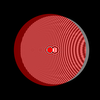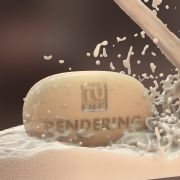Humans perceive their surroundings by the light that is reflected from surfaces. In particular, it is the fine detail observed on surfaces that provides clues about material properties like roughness, texture, temperature, etc. Similarly, in interactive computer graphics applications, the complexity of surface renderings is one of the first things that occur to an observer when judging how good or realistic the application looks. One key issue is to provide the same amount of visual detail as a real surface. This plays an important role in a number of interactive applications where the viewpoint and illumination change rapidly, including visual impact analysis, cultural heritage, design reviews, architecture and urban planning, driving and traffic simulation, engineering and computer games to name but a few. The aim of the Desiree project is to develop algorithms and data structures to efficiently acquire, store and display geometrically complex surfaces for such real-time applications.
Adding surface detail has been a research topic since the early days of computer graphics, including texture mapping, displacement mapping and slice-based representations. However, none of these approaches can directly be used for the aforementioned applications due to insufficient image quality, non-interactivity or too high memory requirements. In addition, no tools are available to convert the complex models created by 3D artists into representations useful for fast and high-quality display.
In Desiree, the main strategy will be to treat the rough object shape and the fine-scale details separately. We will research efficient data structures and algorithms that consider all aspects of this strategy, starting from the decomposition of a complex mesh into low- and high-detail components, efficient representations for the high-detail components, different mappings from the high-detail to the low-detail representation, and high-quality rendering in real time, including anti-aliasing issues and realistic illumination. For rendering, we will exploit recent programmable graphics hardware to develop output-sensitive display algorithms based on ray casting. We believe that this concept will allow us to achieve both, high image quality and real-time frame rates at the same time.
Funding
- FWF P20768-N13
Research Areas
- In this area, we concentrate on algorithms that synthesize images to depict 3D models or scenes, often by simulating or approximating the physics of light.
Publications
13 Publications found:
Download list as Bibtex, HTML (Advanced, Expert), JSON (with referenced objects), CSV, Permalink
| Image | Bib Reference | Publication Type |
|---|---|---|
| 2013 | ||
 |
Aaron Meier-Stauffer Realistic Local Lighting in Dynamic Height Fields [  poster] [ poster] [ thesis] thesis] |
Master Thesis |
 |
Thomas Auzinger, Michael Wimmer , Stefan Jeschke , Stefan JeschkeAnalytic Visibility on the GPU Computer Graphics Forum (Proceeding of EUROGRAPHICS 2013), 32(2):409-418, May 2013. [  Paper] Paper] |
Journal Paper with Conference Talk |
| 2012 | ||
 |
Thomas Auzinger, Michael Guthe, Stefan Jeschke Analytic Anti-Aliasing of Linear Functions on Polytopes Computer Graphics Forum (Proceedings of EUROGRAPHICS 2012), 31(2):335-344, May 2012. [  Paper] Paper] |
Journal Paper with Conference Talk |
 |
Reinhold Preiner , Stefan Jeschke, Michael Wimmer , Stefan Jeschke, Michael Wimmer Auto Splats: Dynamic Point Cloud Visualization on the GPU In Proceedings of Eurographics Symposium on Parallel Graphics and Visualization, pages 139-148. May 2012. [  draft] draft] |
Conference Paper |
| 2011 | ||
 |
Marcel Nürnberg Cell-Based Object Representation [  Poster] [ Poster] [ thesis] thesis] |
Master Thesis |
 |
Stefan Jeschke, David Cline, Peter Wonka Estimating Color and Texture Parameters for Vector Graphics Computer Graphics Forum, 30(2):523-532, April 2011. [  paper] paper] |
Journal Paper with Conference Talk |
 |
Stefan Jeschke Estimating Color and Texture Parameters for Vector Graphics, 20. April 2011-25. February 2011, Rostock, Germany [  image] [ image] [ |
Invited Talk |
 |
Stefan Jeschke Estimating Color and Texture Parameters for Vector Graphics, 30. June 2011, Prague (Czech Republic) |
Invited Talk |
| Daniel Prieler Patchmatch for Texture Synthesis |
Student Project | |
| 2010 | ||
 |
Stefan Jeschke Rendering Diffusion Curves in 2 and 3 Dimensions, 7. October 2010- 8. October 2010, MPII Saarbruecken [  image] image] |
Invited Talk |
| 2009 | ||
 |
Stefan Jeschke, David Cline, Peter Wonka A GPU Laplacian Solver for Diffusion Curves and Poisson Image Editing Transaction on Graphics (Siggraph Asia 2009), 28(5):1-8, December 2009. [  paper] [ paper] [ |
Journal Paper with Conference Talk |
 |
Stefan Jeschke, David Cline, Peter Wonka Rendering Surface Details with Diffusion Curves Transaction on Graphics (Siggraph Asia 2009), 28(5):1-8, December 2009. [  paper] paper] |
Journal Paper with Conference Talk |
 |
Deepali Bhagvat, Stefan Jeschke, David Cline, Peter Wonka GPU Rendering of Relief Mapped Conical Frusta Computer Graphics Forum, 8(28):2131-2139, 2009. [  paper] paper] |
Journal Paper (without talk) |

